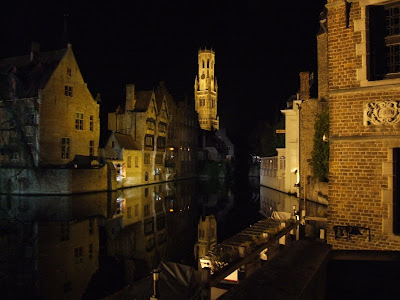Learning about St Aloysius during some time off
 As this week is the seminary and school half-term holiday, I managed to get away for a couple of days to Bruges, one of my favourite European cities. With the new station at Ebbsfleet only 20 minutes away by car, I can be there in a few hours via Eurostar.
As this week is the seminary and school half-term holiday, I managed to get away for a couple of days to Bruges, one of my favourite European cities. With the new station at Ebbsfleet only 20 minutes away by car, I can be there in a few hours via Eurostar.There are several Churches open during the day and I enjoy walking from one to another, saying some of the office in each one. The Church of St Elizabeth at the Beguinage is the quietest, but the Cathedral of Sint Salvator and the Vrouwekerk (Church of Our Lady) have little chapels set aside for prayer as well as boasting some wonderful works of sacred art. Then there is the Basilica of the Holy Blood where the relic can be venerated each day. (In English, we would normally refer to the "Precious Blood" but "Holy Blood" seems to be the official designation.) On this visit, I enrolled into the "Pious Society of the Most Precious Blood."
 Over meals and stops for coffee, I have been reading the life of St Aloysius Gonzaga by Fr Maurice Meschler. C C Martindale, in his introduction to the 1911 edition remarks that the life and character of St Aloysius have proved unattractive, "especially to English boys" and says:
Over meals and stops for coffee, I have been reading the life of St Aloysius Gonzaga by Fr Maurice Meschler. C C Martindale, in his introduction to the 1911 edition remarks that the life and character of St Aloysius have proved unattractive, "especially to English boys" and says:This may be due in large measure to the unfortunate tendency of modern iconography to soften his extremely marked features into a conventional regularity, and to impart to his representations a languishing air wholly out of keeping with his ardent and masculine personality.Thomas Nelson in his introduction to the TAN edition put it more bluntly, suggesting that St Aloysius might appear to us as
a namby-pamby, goodie-goodie, pampered and sickly little softie.In fact, St Aloysius had to endure great psychological pressure from his family, and especially his father, who was horrified that he would throw up his (very considerable) worldly position to become a Jesuit. His mother took consolation from supposing (correctly) that his Jesuit superiors would order him under obedience to moderate the physical penances that he imposed on himself. His interior mortification was even more heroic, made all the more impressive by the fact that he was constantly plagued by the attention of people who knew his former worldly standing.
St Aloysius is invoked as the patron of Christian youth and deserves a reappraisal. As a hero of single-minded and determined devotion to Christ, he has much to teach all of us, but especially the young who wish to do great things for Our Lord.
